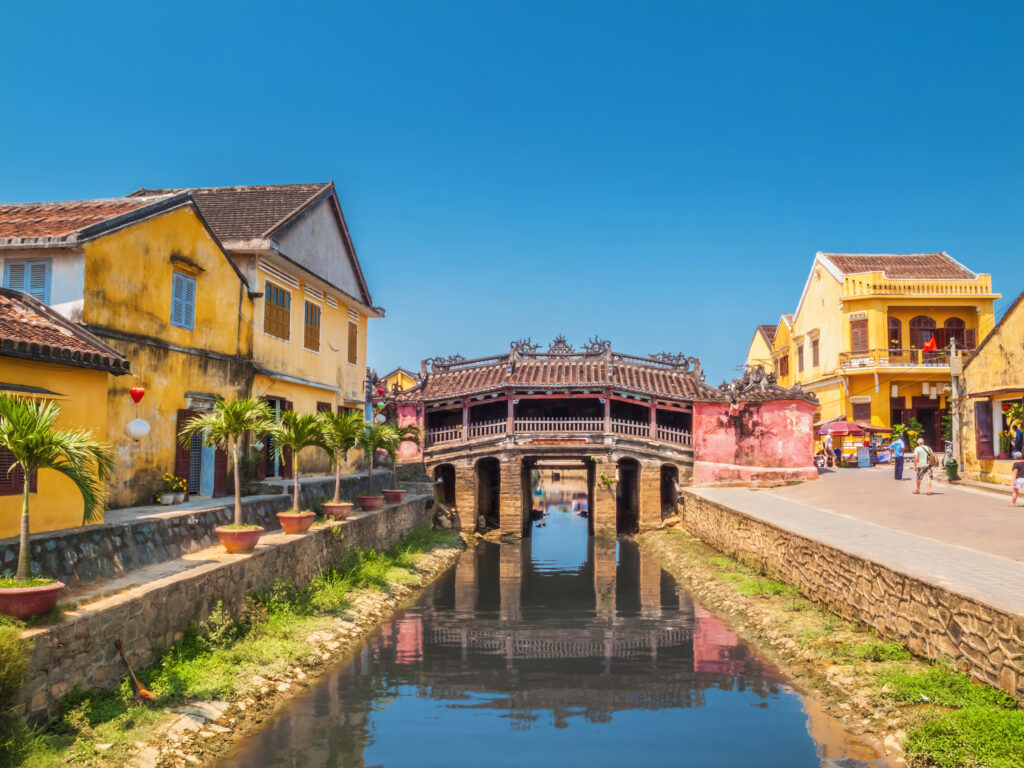
Hoi An is more than just a well-preserved trading port from the 15th to 19th centuries—it’s a place where history, culture, and beauty collide to create one of the most atmospheric destinations in Vietnam, and arguably in all of Southeast Asia. With its winding streets filled with charming historic houses, tranquil pagodas, and cozy cafés, it’s no surprise that visitors are drawn to Hoi An’s unique charm. Whether you’re here for the vibrant market, the handmade clothing shops, or simply to relax and unwind, Hoi An offers a peaceful retreat in an otherwise fast-paced country. And if you’re craving some time by the sea, a serene beach is just a 20-minute bike ride from the heart of town.
5 Compelling Reasons to Visit Hoi An
Best things to do in Hoi An
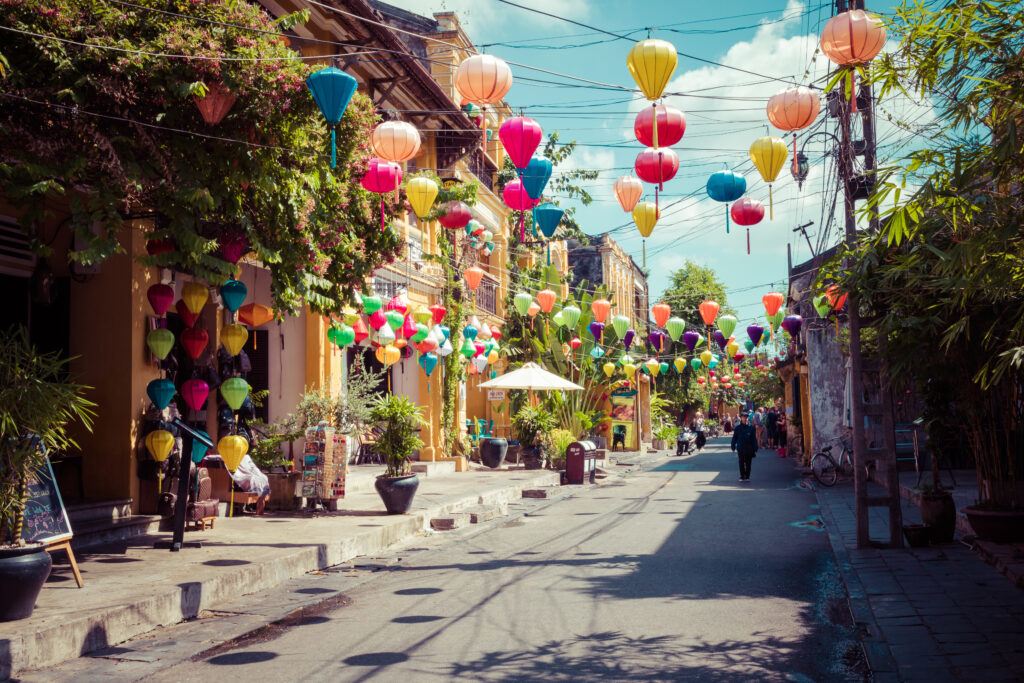
- Explore Vietnam’s Most Atmospheric Old Town
Hoi An’s old town is like stepping back in time, with beautifully preserved architecture and lantern-lit streets that seem to glow with history. Whether you’re wandering during the day or exploring by night, the ambiance is magical. - Cycle Through Lush Rice Fields in the Countryside
Take a bike ride out of the town and you’ll find yourself cycling through vibrant green rice fields, catching glimpses of local life and breathing in the fresh countryside air. - Unwind on One of the Nearby Beaches
Just a short bike ride away, Hoi An’s beaches offer the perfect escape for those looking to relax by the sea. Spend a day soaking in the sun or enjoying a peaceful stroll along the shore. - Experience Hoi An at Night, Lit by Lanterns
At night, the streets of Hoi An come alive with colorful lanterns, illuminating the streets in a soft glow. Walking through the lantern-lit alleys is like a dream and something you won’t want to miss. - Take a Day Trip to My Son or Cham Island
Hoi An is perfectly located for exciting day trips. Whether you’re exploring the ancient ruins of My Son or snorkeling off the coast of Cham Island, there’s plenty of adventure waiting just beyond the town.
Practical Information for Your Hoi An Visit
Best things to do in Hoi An
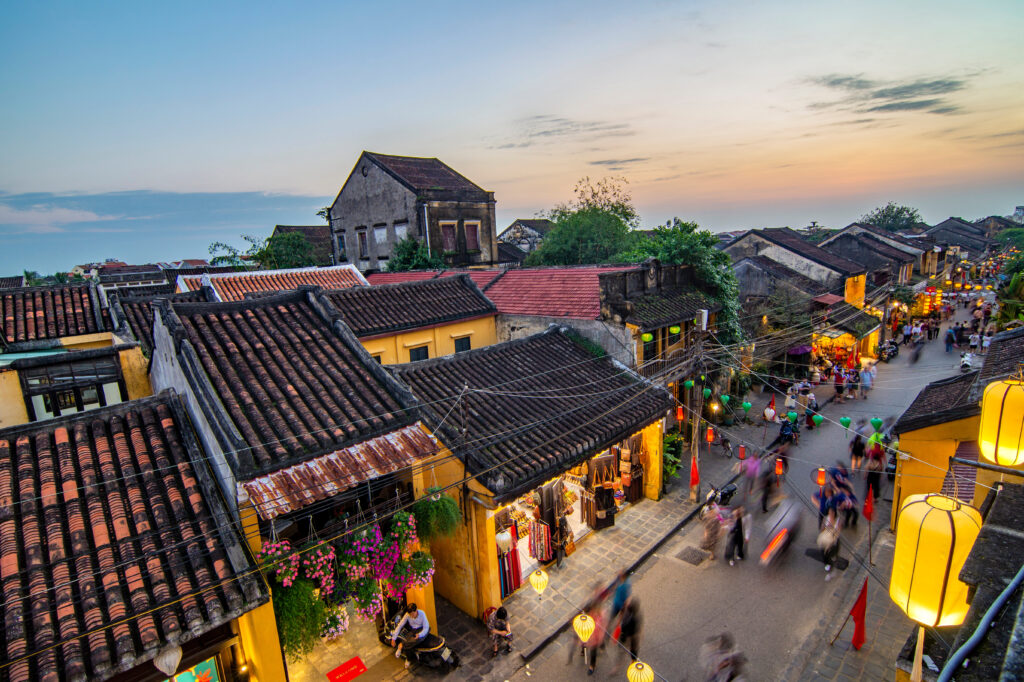
How Many Days to Stay in Hoi An?
Hoi An is the kind of place where you’ll find it easy to linger. While you can explore much of the town in a few days, many visitors stay a week or longer, using it as a base to discover nearby attractions and enjoy the relaxed pace. From cycling tours through the countryside to lounging on the beach, Hoi An offers plenty of activities to fill your days.
Local Events and Holidays
- Mid-Autumn Festival (Tet Trung Thu): Taking place on the 14th and 15th of the eighth lunar month, this festival lights up the town with a lantern parade, traditional games, and musical performances.
- Full Moon Festival: Every full moon, Hoi An’s old town becomes a pedestrian-only zone where lanterns take center stage. The streets are filled with traditional music, markets selling local handicrafts, and the magical glow of colorful lanterns.
ATMs & Money Exchange
You’ll find plenty of ATMs in and around the town, but if you’re heading to the beach or countryside, it’s a good idea to withdraw cash beforehand, as ATMs are less common in these areas.
Best Time to Visit Hoi An
Hoi An has a distinct weather pattern, so timing your visit is key:
- February to April: These months offer pleasant temperatures and low humidity, making it ideal for exploring the town and countryside.
- June to August: Expect the hottest weather, with temperatures soaring to 38°C (100°F). It’s perfect for beach days but be prepared for the heat.
- September to January: This is Hoi An’s rainy season, with October and November seeing the most rainfall. Although it can get wet, the town is still beautiful.
- November to January: Temperatures cool down, ranging between 19-24°C (66-75°F), offering a more comfortable climate for sightseeing.
For more tips on the best times to visit not just Hoi An but all of Vietnam, check out our guide on the Best Time to Visit Vietnam.
Getting Around Hoi An

Hoi An’s compact size makes it easy to explore on foot or by bicycle. If you’re feeling adventurous, you can rent a bike and explore the surrounding countryside, heading to the nearby beaches or taking a scenic ride through the rice fields. Cycling is also a wonderful way to experience the town, offering a relaxing pace as you pedal through its winding streets.
If you’re looking for a more guided experience, consider joining a cycling tour with Jackfruit Adventure, where you’ll be taken through the highlights of Hoi An, including local villages and hidden gems.
Hoi An is not just a destination; it’s an experience that stays with you long after you’ve left. From its lantern-lit streets to its ancient architecture, Hoi An offers a window into Vietnam’s rich history and culture. Whether you’re cycling through the lush countryside, lounging on the beach, or simply enjoying a quiet cup of coffee by the river, Hoi An invites you to slow down and savor every moment.
And if you’re looking to explore even more during your stay in Vietnam, don’t forget to check out other incredible destinations! Discover 25 Unusual Things to Do in Ho Chi Minh City, 12 Must-Do Tours, and Top 10 Romantic Things to Do in Ho Chi Minh City for a truly unforgettable trip. Hoi An may be timeless, but there’s always more adventure waiting around the corner.
15 Best Things to Do in Hoi An
Most sights in Hoi An are located in the enchanting Ancient Town, a historic area that you can easily explore on foot. But there’s so much more to see and do beyond its charming old streets. From lush rice fields and scenic beaches to islands and traditional craft villages, Hoi An offers a range of activities that go beyond the typical tourist experience.
The beauty of Hoi An lies in the variety of experiences it offers. You can cycle through the tranquil countryside, take a serene boat trip along the river, have custom clothing made by skilled tailors, join a cooking class to learn the secrets of Vietnamese cuisine, or embark on a day trip to the ancient ruins of My Son. Here’s a list of top attractions and activities to get the most out of your visit to this picturesque town.
Things to do in Hoi An: Explore the Ancient Town
Best things to do in Hoi An
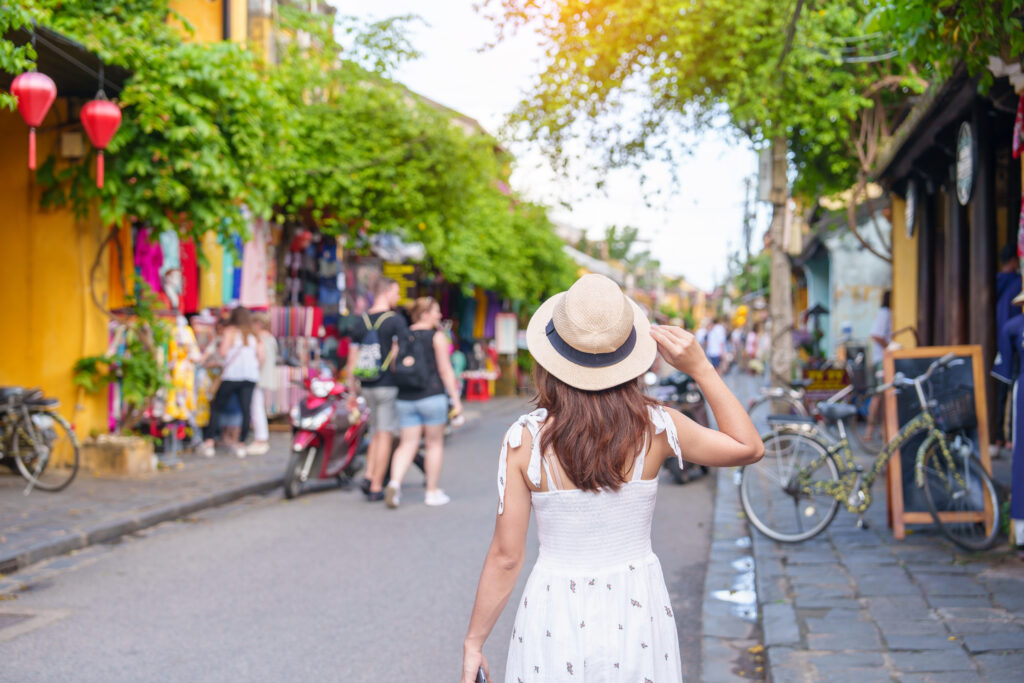
Step back in time as you wander through Hoi An’s Ancient Town, a beautifully preserved slice of history that serves as the heart and soul of this enchanting destination. As you stroll along the narrow, winding streets, you’ll feel the essence of Hoi An’s cosmopolitan past, where Chinese merchants, Japanese traders, and European settlers once walked.
The Ancient Town is like a living museum, showcasing a unique blend of architectural styles that reflect its rich cultural heritage. From the iconic Japanese Covered Bridge to the intricately decorated Chinese assembly halls, every corner holds a story waiting to be discovered. The colorful lanterns that adorn the streets, especially in the evening, add to the magical atmosphere.
Key highlights to explore
- Japanese Covered Bridge: This 18th-century landmark is not just a bridge but also a temple. Its distinctive architecture, guardian statues, and detailed carvings make it one of Hoi An’s most famous attractions.
- Tan Ky Old House: A 200-year-old merchant’s home that offers a glimpse into the daily life of Hoi An’s wealthy traders. The fusion of Japanese, Chinese, and Vietnamese design elements creates a unique atmosphere.
- Phuc Kien Assembly Hall: Dedicated to the sea goddess Thien Hau, this ornate Chinese assembly hall is a striking display of intricate carvings and stunning architecture.
- Old Town Market: Immerse yourself in the daily hustle and bustle of Hoi An by visiting this lively market, filled with the scent of fresh produce, spices, and street food. It’s a sensory delight, where the vibrant colors and sounds of locals bargaining create an authentic Vietnamese experience.
Pro Tip
The best time to explore the Ancient Town is early morning when the streets are quiet, and the soft light casts a magical glow over the buildings. If you’re looking for something more atmospheric, visit in the evening when hundreds of colorful lanterns light up the streets, creating a dreamlike ambiance. Take in the cool evening air, hear the gentle murmur of conversations, and watch as the town comes alive in a way that feels straight out of a fairytale.
Remember to purchase an Old Town ticket, which grants you access to five heritage sites of your choice. This not only allows you to delve deeper into Hoi An’s history but also helps preserve these cultural treasures for future generations.
Things to do in Hoi An: Cycle Through the Countryside
Best things to do in Hoi An

While Hoi An’s Ancient Town is undoubtedly captivating, some of the town’s most authentic experiences lie just beyond its borders. One of the best ways to explore the surrounding countryside is by bicycle, allowing you to immerse yourself in the rural landscapes and local life at a leisurely pace. It’s here, beyond the tourist hub, where Hoi An reveals its true charm—quiet roads, lush rice paddies, and a way of life that feels untouched by modernity.
Cycling through Hoi An’s outskirts offers a refreshing contrast to the bustling streets of the old town. As you pedal through the serene countryside, you’ll encounter locals going about their daily routines, traditional farming methods, and natural beauty at every turn. Here’s what you can expect on your cycling adventure:
Highlights of Countryside Cycling
- Rice Paddies: Imagine pedaling through vast expanses of emerald-green rice fields, with farmers in conical hats quietly tending their crops. Depending on the season, you’ll witness everything from newly planted rice shoots to golden fields ready for harvest. The air is fresh, and the sight of workers using time-honored farming methods is a glimpse into Vietnam’s agricultural heritage.
- Rural Villages: In the small villages scattered around Hoi An, life moves at a slower pace. You’ll pass homes where families gather, see locals weaving baskets or making rice paper, and spot vegetable gardens that supply the local markets. Don’t be surprised if the friendly locals greet you with a wave or a smile—it’s part of the warm Vietnamese hospitality that makes cycling here so special.
- Cam Kim Island: Cross the bridge to this nearby island, where traditional woodcarving is a way of life. Watch artisans skillfully craft everything from furniture to delicate statues using age-old techniques. This peaceful island is the perfect escape from the tourist crowds, and you can even pick up a unique hand-carved souvenir.
- Tra Que Vegetable Village: This organic herb and vegetable village supplies many of the restaurants in Hoi An. A stop here offers a chance to learn about traditional farming methods, and if you’re lucky, you’ll be invited to sample some of the freshest produce you’ve ever tasted. There’s something peaceful about watching farmers tend their crops, knowing that this simple way of life has sustained generations.
- An Bang Beach: After exploring the countryside, reward yourself with a stop at An Bang Beach. Just a 20-minute bike ride from the center of town, this beautiful stretch of coastline offers a refreshing dip in the East Sea (South China Sea). Whether you want to swim, relax on the sand, or grab a drink at a beachfront café, this beach is the perfect place to unwind after a morning of cycling.
- Water Coconut Palm Forest: Venture into this unique ecosystem in the Cam Thanh commune, where you can take a traditional coracle boat ride through the tranquil waterways. The lush greenery and quiet atmosphere make this part of your cycling journey feel like a hidden oasis.
Popular Cycling Routes
- Hoi An to An Bang Beach: A leisurely 5km ride along quiet roads, offering picturesque views of rice fields along the way.
- Hoi An to Tra Que Vegetable Village: A short 3km journey that takes you past vibrant green fields to this charming farming village.
- Countryside Loop: For a longer adventure, this route takes you through rural villages, across rivers, and past scenic viewpoints, providing a full day of exploration.
Practical Tips
- Renting a Bike: You can easily rent a bicycle from your hotel or any of the local rental shops in town. Prices are very affordable, often costing just a few dollars for the day.
- Timing: Start your ride early in the morning to avoid the midday heat and enjoy the cooler, calmer atmosphere.
- Sun Protection: Don’t forget to bring sunscreen, a hat, and plenty of water to stay hydrated, especially during the hotter months.
- Road Conditions: While the roads in town are well-paved, some paths in the countryside may be unpaved or a little bumpy. Be prepared for a bit of an adventure!
- Bike Safety: Always lock your bike when you stop, and be mindful of traffic when crossing busier streets. In the countryside, keep an eye out for water buffalos and other animals that might wander onto the paths.
Safety Note
Cycling through Hoi An is generally safe, but it’s important to be cautious when crossing busier roads or riding near motorbikes. In rural areas, you may find water buffalo or ducks crossing your path, adding a touch of charm to your ride but also requiring a bit of awareness.
Exploring Hoi An’s countryside by bicycle is a perfect way to experience the rhythm of rural Vietnamese life. It allows you to slow down, connect with the land, and engage with the locals in a way that goes beyond the typical tourist experience. Whether you’re cycling past shimmering rice paddies or stopping to chat with a farmer, these moments will leave you with memories of Vietnam that are rich, personal, and unforgettable.
Things to do in Hoi An: Take a Cooking Class
Best things to do in Hoi An

One of the best ways to truly immerse yourself in Vietnamese culture is through its cuisine, and Hoi An offers some of the most authentic and delightful culinary experiences in the country. Taking a cooking class here is not just about learning recipes; it’s a journey into the heart of Vietnamese gastronomy, traditions, and local life.
Most cooking classes in Hoi An follow a similar format, but each offers its unique twist:
- Market Tour: Your culinary adventure often begins with a guided tour of the local market. Here, you’ll learn about the vibrant world of Vietnamese ingredients, herbs, and spices. Walking through the bustling stalls, you’ll discover a sensory overload of colors, aromas, and flavors that will awaken your inner chef and give you a deeper understanding of the key ingredients that make Vietnamese food so unique.
- Herb Garden Visit: Some cooking classes take you a step further by visiting organic herb gardens. You’ll have the chance to pick fresh ingredients such as lemongrass, mint, and coriander, which you’ll use in your cooking. This farm-to-table experience not only adds authenticity to your dishes but also highlights the importance of fresh produce in Vietnamese cuisine.
- Hands-on Cooking: Under the guidance of skilled local chefs, you’ll learn to prepare a variety of Vietnamese dishes. Whether you’re rolling fresh spring rolls, crafting the perfect bowl of pho, or assembling a banh xeo, you’ll develop new skills and techniques that you can recreate at home. The classes are hands-on, so you get to practice each step yourself while receiving helpful tips from your instructor.
- Cultural Insights: As you cook, your instructor will share fascinating stories about Vietnamese food culture, traditional cooking methods, and the significance of each dish in daily life and celebrations. It’s a great way to gain insight into the broader context of the food you’re preparing, making the experience both educational and deeply enriching.
- Feast on Your Creations: The grand finale is, of course, the opportunity to taste your creations. After all the hard work, sit down with your fellow cooks and savor the fruits of your labor. There’s something truly special about enjoying a meal that you’ve prepared yourself, especially when it’s rooted in centuries of culinary tradition.
Popular Dishes You Might Learn to Cook
- Pho Bo (beef noodle soup): Learn the art of making this iconic Vietnamese dish, from crafting the rich broth to perfecting the delicate balance of flavors.
- Banh Xeo (crispy pancakes): Discover how to make these crispy, savory pancakes filled with pork, shrimp, and bean sprouts.
- Cao Lau: Master Hoi An’s signature noodle dish, a unique combination of pork, fresh herbs, and thick noodles, distinct to the town.
- Goi Cuon (fresh spring rolls): Roll up these light, healthy, and delicious appetizers using fresh ingredients wrapped in rice paper.
- Banh Mi: Learn how to make Vietnam’s famous sandwich with a crispy baguette filled with flavorful ingredients.
Recommended Cooking Schools
- Hoiana Resort & Golf Cooking Class: Set in a tranquil rural location, this cooking school offers a relaxing environment with picturesque views and high-quality instruction.
- Green Bamboo Cooking School: Known for its intimate, personalized classes, this school provides a wonderful balance of learning and fun.
- My Grandma’s Home Cooking: Offering a more homely, traditional experience, this school focuses on recipes passed down through generations, giving you a truly authentic taste of Vietnam.
Pro Tip
Book your cooking class early in your trip. The knowledge you gain will enhance your dining experiences throughout the rest of your stay in Vietnam, allowing you to appreciate the dishes you try with a deeper understanding of their ingredients and preparation methods.
Taking a cooking class in Hoi An is more than just a tourist activity; it’s a window into the soul of Vietnamese culture, a chance to connect with locals, and an opportunity to bring a piece of Vietnam back home with you. Whether you’re a culinary novice or a seasoned chef, this experience is sure to be a highlight of your Hoi An adventure.
Things to do in Hoi An: Relax on the Beach
Best things to do in Hoi An

After a full day of exploring the historical sites and streets of Hoi An, you might be ready to unwind and soak in some coastal vibes. Luckily, Hoi An boasts a couple of beautiful beaches that offer the perfect escape for a day of relaxation. The two most popular beaches, An Bang Beach and Cua Dai Beach, are easily accessible from the town center. Whether you choose to cycle, hop on a scooter, or take a quick taxi ride, these beaches provide a refreshing retreat from the bustling streets.
If you’re up for a little adventure, the beaches of Da Nang, located just a short drive away, are also worth exploring. Here’s what you can expect during your beach day in Hoi An:
Things to Do at the Beach
- Sunbathing: If you’re in need of a day to unwind, grab a lounger and umbrella for a relaxed day under the warm Vietnamese sun. The beaches in Hoi An are well-maintained, and renting a beach chair is affordable, making it a great way to enjoy the scenery in comfort.
- Swimming: With their gentle waves, the waters of An Bang and Cua Dai are generally safe for swimming. Always be sure to check local conditions and adhere to any warnings from lifeguards.
- Water Sports: For those looking to add a bit of activity to their beach day, you can rent equipment for water sports like surfing, paddleboarding, or kayaking. If you’re new to these activities, there are often lessons available to get you started.
- Beach Walks: A peaceful walk along the shoreline during sunrise or sunset is a simple yet beautiful way to take in the natural beauty of Hoi An’s coast. The beaches here are less crowded in the mornings, providing a quiet and tranquil setting to start your day.
- Yoga: Join a beachfront yoga session for a rejuvenating start to your morning. Many local yoga instructors offer classes right on the sand, with the sound of the waves creating the perfect backdrop for relaxation and mindfulness.
Practical Tips
- Getting There: Renting a bicycle is a great way to reach the beaches from Hoi An town, offering a scenic and easy ride. Alternatively, you can take a short taxi or scooter ride to the coast.
- Timing: For a quieter, more peaceful beach experience, visit in the early morning when the beach is less crowded, or come in the late afternoon to enjoy the vibrant beach life and catch the stunning sunset.
- Facilities: Public restrooms, showers, and changing rooms are available, making it convenient to freshen up after a swim or day in the sun.
- Safety: While the beaches are generally safe, it’s always a good idea to keep an eye on your belongings. Use basic precautions and keep your valuables secure.
Pro Tip
For those seeking a more secluded spot, take a walk further north along An Bang Beach. The farther you go from the main entrance, the quieter and more peaceful it becomes, offering a perfect escape from the crowds.
The beaches near Hoi An offer the perfect balance between adventure and relaxation, whether you’re keen to dive into water sports or simply lie back and enjoy the gentle sounds of the sea. After exploring the rich history and culture of Hoi An’s Ancient Town, a day on the beach provides a wonderful contrast, allowing you to fully relax and recharge before continuing your journey.
Things to do in Hoi An: Take a Sunset Boat Ride on the Thu Bon River
Best things to do in Hoi An

As the day draws to a close, one of the most serene and magical ways to experience the charm of Hoi An is by embarking on a sunset boat ride along the Thu Bon River. This river, which has been the town’s lifeblood for centuries, offers a calm escape from the bustling streets, giving you a front-row seat to Hoi An’s peaceful beauty and historical significance.
A sunset boat ride provides not only stunning views but also a chance to slow down and reflect on the day’s experiences. Here’s what you can look forward to during this enchanting journey on the water:
What to Expect
- Scenic Views: As the boat glides smoothly along the river, you’ll be treated to panoramic views of Hoi An’s historic waterfront, with its colorful houses and palm trees beautifully silhouetted against the setting sun. The sky transforms into vibrant shades of orange and pink, offering a perfect backdrop for photos.
- Rural Landscapes: Beyond the town center, the riverbanks reveal a more rural side of life. You’ll pass by farmers working in their fields, water buffalo grazing, and local fishermen casting their nets, giving you a glimpse of daily life untouched by tourism.
- Cua Dai Estuary: Some tours take you all the way to where the Thu Bon River meets the East Sea at the Cua Dai Estuary. Here, the vast expanse of the ocean opens up, and the coastline unfolds before you in a breathtaking display.
- Lantern-Lit Town: As you return to town after the sun has set, Hoi An’s famous lanterns begin to light up the streets, creating a dazzling display of color and light along the river. From the water, this transformation is even more magical, as the twinkling lights reflect off the river’s surface.
- Local Life: Throughout the boat ride, you’ll observe the rhythm of riverside life. Locals might be seen washing clothes in the river, families gathering for dinner near the water’s edge, or children playing by the riverbank—giving you a heartwarming glimpse of everyday life.
Types of Boat Experiences
- Traditional Wooden Boats: These small, rustic boats offer a more authentic experience. The quietness of the ride allows you to fully appreciate the beauty and tranquility of the surroundings, and these boats can also navigate narrower waterways for a more intimate tour.
- Modern Tour Boats: If you prefer a bit more comfort, there are larger tour boats available, often offering amenities like drinks and snacks. These boats are perfect for groups looking for a leisurely, social experience while enjoying the scenic views.
- Private Sampans: For a more personalized and intimate journey, hire a private sampan (a flat-bottomed wooden boat) with a local boatman. This option allows you to set your own pace and explore the quieter sections of the river.
- Dinner Cruises: Some tour operators offer dinner cruises, which combine the beautiful sunset views with a meal of traditional Vietnamese dishes. Savor local specialties while floating down the river, making for a romantic and memorable evening.
Practical Tips
- Book in Advance: During peak season, sunset boat rides can fill up quickly. It’s a good idea to book your trip in advance to secure your spot.
- Arrive Early: Plan to arrive at the departure point about 15 minutes early to ensure a smooth start to your ride and give yourself time to soak in the surroundings.
- Dress Comfortably: As the sun sets, the temperature can drop slightly. Bring a light jacket or sweater to stay comfortable on the water.
- Bring Your Camera: The views along the Thu Bon River are incredibly photogenic, especially during sunset and as the lanterns start to light up. You’ll want to capture these magical moments.
- Insect Repellent: Depending on the time of year, mosquitos may be present around the river, especially during the rainy season. Bring some insect repellent to stay comfortable throughout the ride.
Pro Tip
For an even more magical experience, try to time your boat ride to coincide with Hoi An’s Full Moon Festival. The full moon, combined with the thousands of lanterns lighting up the streets and the river, creates an atmosphere that is truly unforgettable.
A sunset boat ride on the Thu Bon River is the perfect way to unwind after a day of sightseeing, offering a peaceful retreat from the bustling streets of Hoi An. The gentle sounds of the water, the stunning views, and the chance to witness local life along the riverbanks make this experience one of the most memorable things to do in Hoi An. Whether you’re seeking relaxation or romance, this activity promises to create lasting memories of your time in this magical town.
Things to do in Hoi An: Shop for Tailor-Made Clothing
Best things to do in Hoi An
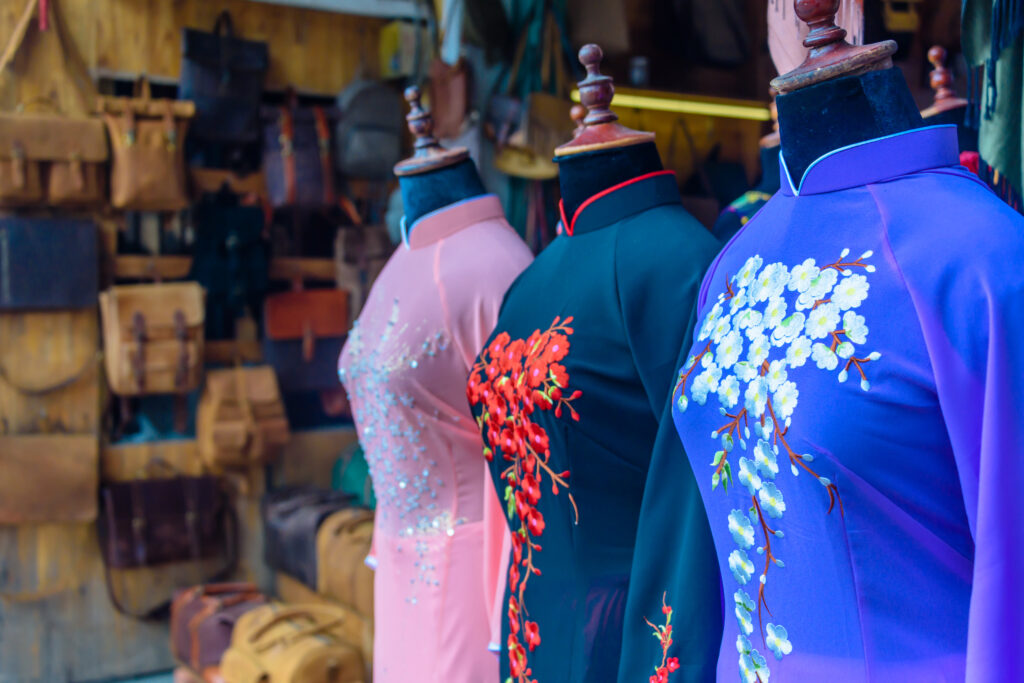
Hoi An is famous for its skilled artisans, particularly in the world of tailoring, where precision and craftsmanship are at their finest. Whether you’re a fashion enthusiast or simply someone looking to add a unique piece to your wardrobe, Hoi An’s tailor-made clothing shops offer an unparalleled shopping experience. With more than 400 tailor shops scattered throughout the town, this is the go-to destination for custom-made fashion in Vietnam, and you can have everything from tailored suits and elegant dresses to custom shoes and bags crafted to your exact specifications.
Why Shop for Tailor-Made Clothing in Hoi An
- Customization: There’s nothing quite like wearing clothing that fits you perfectly. Hoi An’s tailors specialize in creating garments that match your measurements and personal style, ensuring a custom fit.
- Quality: The tailors in Hoi An are known for using high-quality fabrics and delivering exceptional craftsmanship. You’ll be able to choose from a wide variety of materials such as silk, cotton, linen, and wool, ensuring that your clothing looks and feels luxurious.
- Variety: Whether you’re after traditional Vietnamese designs like the elegant ao dai, modern Western styles, or even unique fusion pieces, the tailors here can create it all. They also cater to both men and women, offering endless possibilities for custom clothing.
- Value: The cost of tailor-made clothing in Hoi An is significantly lower than what you would pay for similar items in Western countries. For just a fraction of the price, you can own high-quality, made-to-measure garments that stand the test of time.
What to Expect
- Consultation: Your tailoring experience typically begins with a consultation where you’ll discuss your design preferences, fabric choices, and any specific details you want. Tailors are often able to replicate designs from photos, so feel free to bring references.
- Measurements: After deciding on the style and fabric, your tailor will take precise measurements to ensure that your clothing fits perfectly.
- Fittings: For more complex pieces, you may need one or more fittings to adjust the garment as it’s being made. This ensures a flawless fit and gives you the opportunity to make any changes.
- Final Product: Most items can be completed within 24-48 hours, but more intricate designs may require additional time. Once finished, your tailor will present the final product for you to try on and approve.
Tips for a Successful Tailoring Experience
- Research: Before choosing a tailor, do some research online or ask fellow travelers for recommendations. There are plenty of reviews available to help you find the most reputable shops.
- Bring Examples: If you have a specific design in mind, bring photos or magazine clippings as references. Tailors can often replicate styles to the exact detail.
- Allow Time: Make sure to set aside 2-3 days in Hoi An to allow time for fittings and any necessary adjustments to your clothing.
- Be Specific: Clearly communicate your preferences to the tailor, including any alterations or specific requests. Don’t hesitate to ask for changes if you’re not satisfied with the fit or look.
- Quality Check: Before accepting your finished items, carefully inspect them for any issues, such as loose stitches or fabric quality. It’s better to address these details before leaving the shop.
Recommended Tailor Shops
- Yaly Couture: A well-established shop known for its top-quality fabrics and impeccable craftsmanship. It’s slightly more expensive but consistently delivers high-end results.
- A Dong Silk: This tailor is praised for its excellent customer service, attention to detail, and wide range of fabric choices.
- Bebe Tailor: Popular for both men’s and women’s fashion, Bebe Tailor is known for its reliability and efficient turnaround time.
In Hoi An, shopping for tailor-made clothing isn’t just about fashion—it’s an experience that blends traditional craftsmanship with personal style. You’ll leave with garments that not only fit perfectly but also serve as a lasting memory of your trip. As tempting as it may be to stock up on numerous pieces, focus on quality. A few well-made, custom-tailored items will become cherished pieces in your wardrobe for years to come.
Things to do in Hoi An: Attend a Traditional Performance at Lune Center
Best things to do in Hoi An

To complete your Hoi An experience, there’s no better way to immerse yourself in Vietnamese culture than by attending a traditional performance at the Lune Center. This modern performance space offers an extraordinary fusion of ancient Vietnamese traditions and contemporary artistic expression, making it a must-see for culture enthusiasts visiting Hoi An.
About Lune Center
Located in Hoi An’s Old Town, the Lune Center is a world-class venue dedicated to preserving and showcasing Vietnam’s cultural heritage. The theater hosts a variety of innovative performances, with the most famous being the A O Show, which blends traditional Vietnamese arts with acrobatics, dance, and modern staging techniques.
The performances here are designed not only to entertain but to offer profound insights into the heart of Vietnamese culture, history, and everyday life. Whether you’re a fan of the arts or just looking for a unique way to experience Vietnamese traditions, the Lune Center provides an unforgettable evening of entertainment.
What to Expect
- A O Show: The centerpiece of the Lune Center’s lineup, the A O Show, is an enchanting blend of circus, acrobatics, and theater. It tells the story of Vietnam’s transformation from rural simplicity to bustling urban life, capturing the spirit of the country’s journey through stunning visual and physical performances.
- Traditional Music: The shows feature mesmerizing traditional Vietnamese music played on ancient instruments like the dan bau (monochord) and dan tranh (16-string zither), which enhance the emotional depth of the performances.
- Acrobatics: Be awed by the physical prowess of the performers, who execute complex acrobatic feats with grace and skill, all while using traditional props such as bamboo poles.
- Storytelling: Each show tells a narrative deeply rooted in Vietnamese folklore and history, offering an engaging and educational insight into the culture. From rural villages to urban streets, the stories convey the essence of life in Vietnam.
- Visual Spectacle: The Lune Center’s productions are known for their stunning visuals. From intricate traditional costumes to imaginative set designs using bamboo, the performances are a feast for the eyes as well as the soul.
Tips for Attending a Performance
- Book in Advance: Performances at the Lune Center are incredibly popular, especially during peak tourist seasons. It’s advisable to book your tickets in advance to secure your spot.
- Arrive Early: Aim to arrive at least 30 minutes before the show starts to find your seat and take in the ambiance of the theater. You can also enjoy pre-show activities, which sometimes include live music performances in the foyer.
- Camera Policy: Make sure to check the theater’s rules on photography and video recording before the show begins. Many venues discourage taking photos during the performance to preserve the integrity of the experience.
- Dress Code: There’s no formal dress code at the Lune Center, but smart casual attire is recommended for a comfortable yet respectful theater-going experience.
Attending a performance at the Lune Center is an opportunity to delve deeper into Vietnamese culture through an artistic lens. The unique blend of acrobatics, music, and storytelling ensures that you’ll leave with a richer understanding of Vietnam’s traditions and the creative energy that shapes this country today.
Things to do in Hoi An: Visit My Son Sanctuary
Best things to do in Hoi An
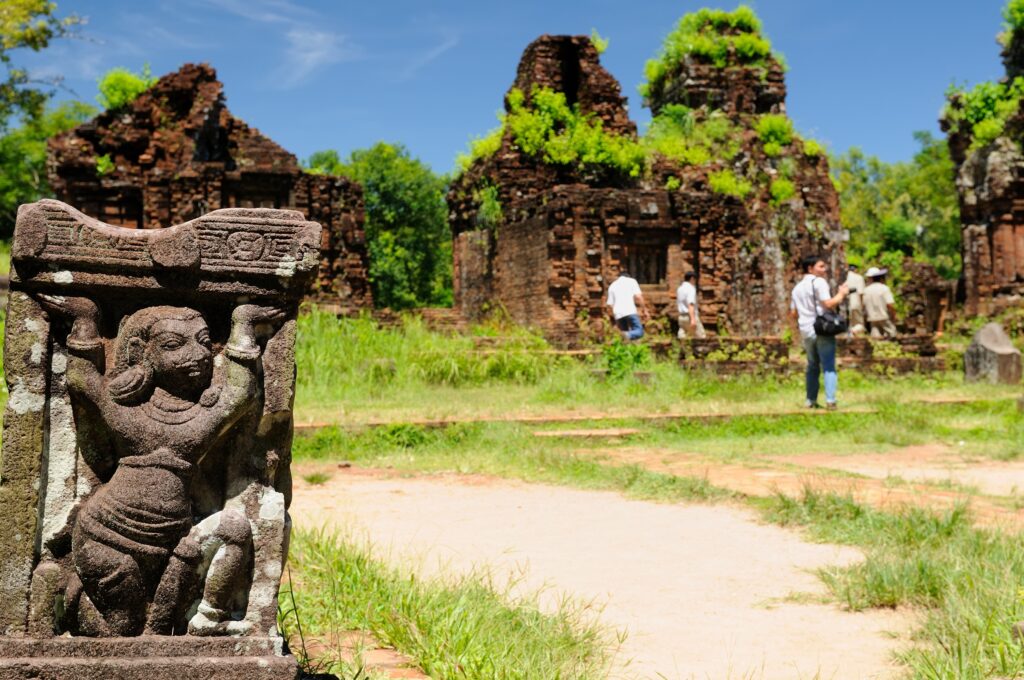
Located about 40 kilometers southwest of Hoi An, My Son Sanctuary is a must-visit destination for history lovers and architecture enthusiasts alike. This UNESCO World Heritage site showcases the remnants of an ancient civilization that once thrived in central Vietnam, offering visitors a glimpse into the spiritual and architectural achievements of the Champa kingdom.
What to Expect at My Son
- Ancient Architecture: My Son is home to a series of impressive brick towers and temples built between the 4th and 13th centuries AD. These structures, once dedicated to Hindu deities, display intricate carvings and sculptures that highlight the Champa civilization’s artistic talents.
- Cultural Significance: My Son was not just an architectural marvel but also a spiritual and political center for the Cham people. The temples served as places of worship and were deeply connected to the kingdom’s religious practices and cultural identity.
- Natural Setting: Nestled in a lush, green valley surrounded by towering mountains, the site exudes a mystical atmosphere. The combination of ancient ruins and natural beauty creates a serene environment perfect for exploration.
- On-Site Museum: After wandering through the ruins, visit the on-site museum to learn more about Cham history and the significance of the sanctuary. The museum houses a collection of artifacts that offer valuable insights into the daily life, religion, and artistry of the Champa people.
Tips for Visiting
- Timing: Arriving early is key to avoiding both the heat and the crowds. The site opens at 6:00 AM, giving early birds a chance to enjoy a peaceful exploration before the midday sun hits.
- Guided Tours: While it’s possible to visit on your own, a guided tour can enrich your experience. Knowledgeable guides can explain the history and symbolism of the structures, adding layers of depth to your visit.
- Footwear: The terrain at My Son is uneven in places, so wearing comfortable walking shoes is essential for navigating the site.
- Respect: My Son is a sacred site, so it’s important to dress modestly and show respect for the ancient structures. Be mindful of the preservation efforts and avoid touching the ruins.
Getting There
- Organized Tour: Many travel agencies in Hoi An offer half-day or full-day tours to My Son. This is a convenient option if you want transportation and guided services included.
- Private Car: Hiring a private car gives you more flexibility in terms of timing and allows you to customize your itinerary. This is a great option if you want to explore My Son at your own pace.
- Motorbike: For those who enjoy a bit more adventure, renting a motorbike is another way to reach the sanctuary. However, keep in mind that the road to My Son can be winding and requires caution, especially if you’re not an experienced rider.
Pro Tip
For a more diverse and scenic experience, consider combining your visit to My Son with a boat trip back to Hoi An. Some tours offer this option, allowing you to enjoy the scenic beauty of the countryside and the Thu Bon River on your return journey.
Visiting My Son Sanctuary offers a fascinating glimpse into Vietnam’s ancient past, providing a stark contrast to the more recent history visible in Hoi An’s Old Town. Exploring this sacred site deepens your appreciation for the cultural and religious legacy of the Champa civilization, enriching your overall experience in central Vietnam.
Things to do in Hoi An: Indulge in Local Cuisine
Best things to do in Hoi An
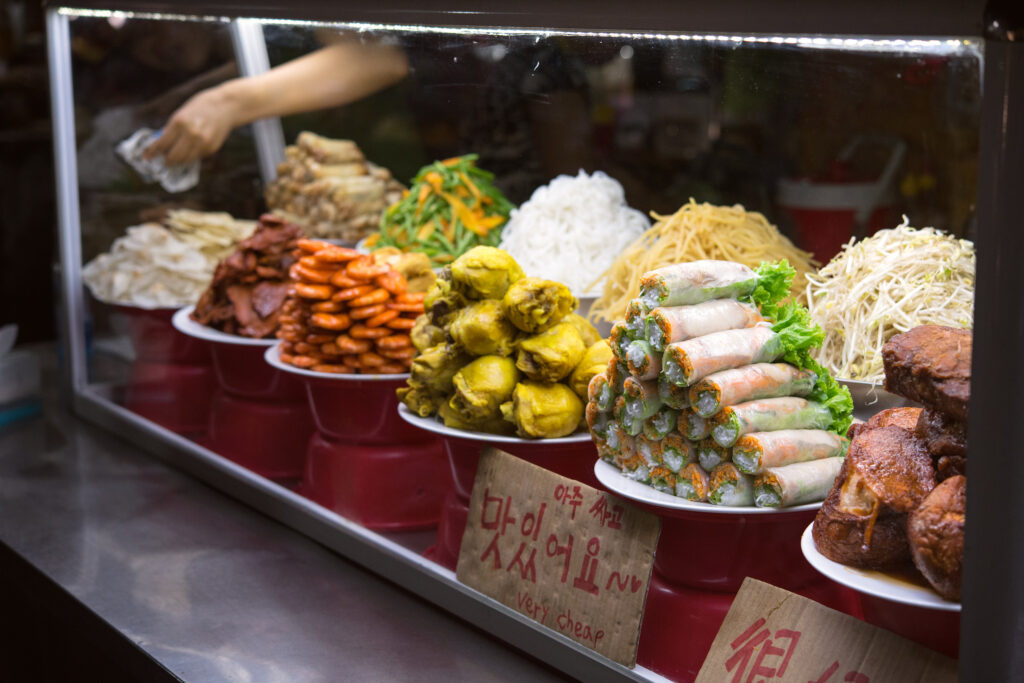
Hoi An is not just a feast for the eyes; it’s also a paradise for food lovers. The town’s unique culinary heritage, influenced by centuries of cultural exchange, has resulted in a diverse and delectable food scene. From humble street food stalls to upscale restaurants, Hoi An offers a gastronomic journey that will tantalize your taste buds with every bite.
Must-Try Local Specialties
- Cao Lau: This iconic Hoi An dish features thick rice noodles, tender slices of pork, crispy croutons, and fresh herbs. The dish’s authenticity lies in the use of water from a specific local well, giving it a distinct flavor that can’t be replicated elsewhere.
- White Rose (Banh Bao Banh Vac): These delicate, translucent dumplings are filled with shrimp and shaped to resemble white roses. This specialty is unique to Hoi An, and the secret recipe is closely guarded by a local family.
- Mi Quang: A hearty noodle dish with a small amount of flavorful broth, mi quang is topped with shrimp, pork, quail eggs, and crushed peanuts for a satisfying meal.
- Banh Mi: While Banh Mi can be found across Vietnam, Hoi An’s version, particularly from Banh Mi Phuong, is often hailed as the best in the country. The perfect blend of savory meats, pickled vegetables, and herbs packed into a crispy baguette makes it a must-try.
- Com Ga (Chicken Rice): A simple yet flavorful dish of rice cooked in chicken broth, served with shredded chicken, herbs, and a side of fresh vegetables.
- Hoanh Thanh (Wonton): Crispy wontons topped with a savory tomato-based sauce are a local favorite and an excellent snack to enjoy as you explore the town.
Where to Eat
- Central Market: For an authentic street food experience, head to the bustling Central Market, where you can sample a variety of dishes from different vendors, each showcasing the rich flavors of Hoi An’s cuisine.
- Madam Khanh – The Banh Mi Queen: Rivaling the famous Banh Mi Phuong, Madam Khanh’s stall offers a delightful version of this iconic sandwich that is sure to satisfy.
- Morning Glory: Run by celebrated local chef Ms. Vy, this upscale restaurant offers a range of traditional dishes, providing a more refined dining experience while still honoring local flavors.
Culinary Experiences
- Street Food Tour: Join a guided street food tour to discover hidden food gems and learn about the history behind each dish, giving you a deeper appreciation for the local cuisine. For more insights into Vietnam’s vibrant street food culture, check out our blog on Vietnamese Street Food.
- Cooking Classes: As mentioned earlier, taking a cooking class is a hands-on way to dive into the art of Vietnamese cuisine. You’ll learn how to make traditional dishes like cao lau and banh xeo, taking these recipes home as a lasting memory of your trip.
- Herb Village Visit: Head to Tra Que Vegetable Village to explore the herb gardens that supply many of Hoi An’s kitchens. A tour here offers a deeper understanding of the fresh herbs that make Vietnamese cuisine so distinctive.
Dining Etiquette Tips
- Chopsticks: It’s customary to use chopsticks for most meals. Be sure not to stick them upright in your rice bowl, as this resembles incense sticks used at funerals—a gesture considered bad luck.
- Slurping Noodles: It’s perfectly acceptable, and even encouraged, to slurp noodles when eating dishes like pho. It’s a sign that you’re enjoying the meal.
- Waiting to Eat: If dining with locals, it’s polite to wait for the eldest person at the table to begin eating before you start.
Food Safety
Hoi An’s street food is generally safe, but it’s best to choose busy stalls with a high turnover of customers to ensure freshness. Stick to bottled water and avoid raw vegetables if you have a sensitive stomach.
Indulging in Hoi An’s local cuisine is more than just satisfying your hunger; it’s about immersing yourself in the town’s rich history, culture, and traditions through the food. Every dish tells a story, and each meal offers an opportunity to connect with the local way of life. So, come with an open mind, an empty stomach, and get ready for a culinary adventure you won’t soon forget!
Things to do in Hoi An: Visit the Lantern Market
Best things to do in Hoi An

As dusk falls, Hoi An transforms into a glowing wonderland, thanks to its famous Lantern Market, which lights up the streets with an ethereal, colorful glow. Often referred to as the “City of Lanterns,” Hoi An’s lantern tradition dates back to the 16th century, introduced by Japanese merchants who believed that hanging lanterns outside their homes would bring good fortune. Today, this custom has evolved into one of the most magical experiences in the city.
What to Expect at the Lantern Market
- Vibrant Displays: As you stroll down Nguyen Hoang Street, you’ll be surrounded by hundreds of lanterns in all shapes, colors, and sizes. The lanterns create a soft, romantic atmosphere that gives the entire town a fairytale-like quality.
- Handcrafted Lanterns: The market is filled with local artisans displaying their skillfully crafted lanterns, from traditional silk designs to more modern variations. Whether you’re shopping for a keepsake or just browsing, you’ll marvel at the craftsmanship on display.
- Lantern-Making Workshops: For those interested in learning about this traditional craft, several shops offer quick workshops where you can create your very own lantern. It’s a fun way to immerse yourself in local culture and take home a handmade souvenir.
- River Lanterns: One of the most charming traditions is purchasing a small paper lantern, making a wish, and releasing it onto the Hoai River. This practice is believed to bring good luck, and watching hundreds of floating lanterns drift downstream is a truly magical sight.
- Street Performances: As you wander through the Lantern Market, you’ll likely come across street performers, from local musicians to dancers, who contribute to the lively and festive atmosphere of the evening.
- Night Market: The Lantern Market also coincides with a broader night market, where you can shop for local souvenirs, handmade crafts, and delicious street food. The combination of lantern-lit streets and the vibrant marketplace is a sensory experience that shouldn’t be missed.
Best Times to Visit
- Evening Hours: The market comes alive around 6:00 PM and remains busy until around 9:30 PM, making it the perfect place to visit after a day of exploring Hoi An.
- Full Moon Lantern Festival: For an even more enchanting experience, plan your visit around the Full Moon Lantern Festival, held on the 14th day of each lunar month. During this special celebration, all electric lights in the Old Town are switched off, leaving the streets illuminated solely by lanterns. It’s a breathtaking sight that adds a deeper spiritual dimension to the market.
Pro Tips
- Bring Cash: Most vendors at the market only accept cash, so be sure to have some on hand for lantern purchases, souvenirs, or snacks.
- Crowd Awareness: The Lantern Market can get crowded, especially on weekends or during peak tourist season. If you prefer a more peaceful experience, try visiting on a weekday.
- Lantern Purchase: If you decide to buy a lantern, many shops offer packaging services to ensure it travels safely. Some even provide shipping options, so you don’t have to carry it throughout your trip.
- Photography: Don’t forget your camera! The streets lined with glowing lanterns make for some of the most picturesque and memorable photos you’ll take during your trip.
Visiting the Lantern Market is not just about appreciating the beauty of the lanterns—it’s about connecting with a long-standing tradition that has shaped Hoi An’s cultural identity. The captivating sight of glowing lanterns against the night sky is something that will stay with you long after you leave. Make sure to immerse yourself fully in the experience, soaking in the beauty, history, and charm that this magical event brings to the streets of Hoi An.
Things to do in Hoi An: Explore Hoi An’s Bustling Markets
Best things to do in Hoi An

Hoi An’s markets offer an authentic glimpse into local life, where the vibrant energy of sellers and shoppers creates a unique atmosphere. From fresh produce to handmade crafts, the markets in Hoi An are a treasure trove of sights, sounds, and scents, giving visitors a taste of the town’s bustling daily life.
Central Market
Located right in the heart of the city by the river, Hoi An’s Central Market is a must-visit for anyone wanting to experience the lively local trade. Here, you’ll find a wide range of items, including fresh vegetables, fruits, spices, and seafood. It’s also a fantastic place to shop for souvenirs, such as handmade crafts, traditional clothing, and beautiful ceramics.
Wandering through the market, you’ll see vendors showcasing their produce, locals haggling over prices, and the occasional tourist marveling at the sheer variety of goods. The Central Market is also a great spot to try some local street food—look for stalls serving up dishes like banh mi, pho, and cao lau, all freshly made and ready to enjoy on the spot.
Night Market
When the sun sets, the lively Hoi An Night Market takes over. Every evening, Nguyen Hoang Street is transformed into a colorful display of lights and activity. The market stretches for 300 meters, lined with stalls selling everything from handmade jewelry and clothing to traditional lanterns and mouthwatering snacks.
What makes the Night Market truly special is its sea of vibrant, glowing lanterns. Hundreds of these handcrafted lanterns illuminate the street, creating a magical, otherworldly atmosphere that draws visitors in. Whether you’re shopping for souvenirs or simply soaking in the ambiance, the Night Market is a feast for the senses.
Highlights of Hoi An’s Markets
- Handmade Goods: Browse through stalls offering beautiful handmade items such as jewelry, silk scarves, and traditional Vietnamese clothing.
- Local Food: Try a variety of snacks and street food, including crispy banh xeo, grilled meats, and sweet desserts like che (a traditional Vietnamese dessert). Don’t miss out on tasting the famous Hoi An banh mi while you’re there.
- Lanterns: The vibrant lanterns sold at the Night Market are one of Hoi An’s most iconic souvenirs. You can even watch local artisans making them on-site and take one home as a memento of your visit.
Tips for Exploring the Markets
- Haggling: Don’t be afraid to negotiate prices. Haggling is a common practice at Vietnamese markets, and it’s all part of the experience.
- Timing: The Central Market is busiest in the morning, while the Night Market begins to come alive around sunset, peaking between 7:00 PM and 9:00 PM.
- Cash: Make sure to carry enough cash, as many vendors don’t accept credit cards.
- Crowds: The Night Market can get crowded, especially during weekends or holidays, so if you prefer a quieter experience, consider visiting earlier in the evening.
Exploring the markets in Hoi An gives you a deeper insight into local culture, from the day-to-day rhythms of the Central Market to the enchanting evening spectacle of the Night Market. It’s a perfect opportunity to experience the town’s vibrant life and take home a piece of Hoi An’s unique charm.
Things to do in Hoi An: Visit Craft Villages Around Hoi An
Best things to do in Hoi An
One of the most enriching experiences you can have in Hoi An is visiting the traditional craft villages located just outside the town. These villages have preserved ancient skills and techniques passed down through generations, giving visitors the chance to witness Vietnamese artisans at work and even try their hand at traditional crafts.
Kim Bong Carpentry Village

Kim Bong Carpentry Village is a renowned destination for woodworking and carpentry, where skilled artisans create everything from fine furniture to detailed architectural carvings. The village is particularly famous for its contribution to the restoration of Hoi An’s historic buildings, including temples, houses, and assembly halls. Walking through Kim Bong, you can watch carpenters working with precision, creating intricate pieces that showcase the centuries-old craftsmanship.
Visitors can also purchase beautiful handmade wood products such as statues, household items, and intricate carvings. If you’re interested in traditional Vietnamese woodworking, this is a must-visit location to see the artisans at work and bring home a truly unique souvenir.
Tra Que Herb Village

For a glimpse into the agricultural side of Hoi An, a visit to Tra Que Herb Village is a rewarding experience. Located just a few kilometers from the city center, this vegetable village offers visitors the opportunity to learn about traditional farming techniques. Local farmers will show you how to plow the soil, plant seeds, water crops, and harvest vegetables using age-old methods. Tra Que is known for its organic herbs and vegetables, many of which are used in Hoi An’s famous cuisine.
Some tours offer hands-on activities where you can participate in the daily farming tasks, followed by a cooking class using the fresh herbs and produce you’ve just harvested. It’s a fantastic way to connect with local life and gain a deeper appreciation for the food you’ll be enjoying in Hoi An.
Thanh Ha Pottery Village
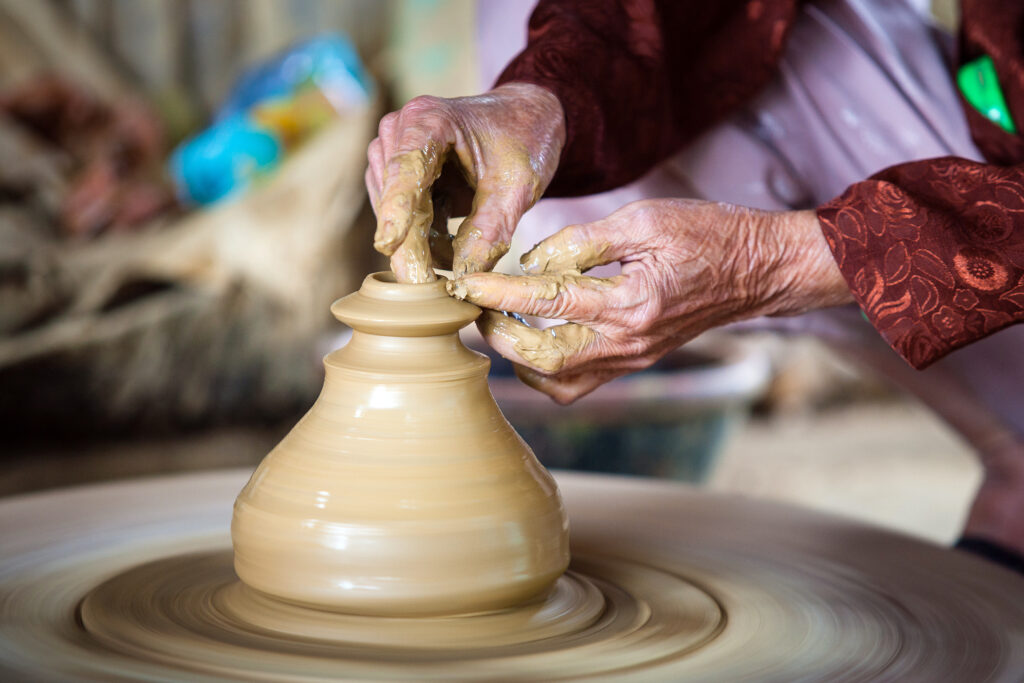
At Thanh Ha Pottery Village, you can witness the ancient art of pottery-making. This village has been producing ceramics for over 500 years, and the traditional techniques have been passed down through generations. Watch potters at work as they shape clay into beautiful vases, pots, bowls, and other decorative items, often without using modern equipment like pottery wheels.
Many workshops in Thanh Ha allow visitors to try their hand at making pottery, offering a fun and creative way to experience the craft. You can take home your own handmade pottery as a memento of your time in Hoi An. Don’t miss the nearby Terracotta Park, which showcases impressive large-scale ceramic sculptures and the history of pottery in Vietnam.
Phuoc Kieu Bronze Casting Village

Phuoc Kieu Bronze Casting Village, located just outside of Hoi An, is another craft village worth visiting. This village has been producing bronze products for over 400 years, including traditional gongs, drums, statues, and other decorative items. The artisans here use traditional methods to create their works, often taking several days or weeks to complete each piece.
Phuoc Kieu is famous for its high-quality gongs, which are used in ceremonies and performances across Vietnam. Visitors can watch the bronze-casting process in action and learn about the significance of these items in Vietnamese culture. If you’re interested in traditional craftsmanship and metalworking, Phuoc Kieu offers a fascinating insight into this ancient art form.
Tips for Visiting Craft Villages
- Transportation: You can easily reach these villages by bicycle, motorbike, or a guided tour. The short ride through the countryside is part of the charm.
- Hands-on Experience: Many of the villages offer interactive workshops where you can try your hand at making pottery, planting herbs, or even wood carving.
- Shopping: These villages are great places to purchase unique, handmade souvenirs that reflect the craftsmanship and culture of Hoi An.
- Respect: Remember that these are working villages, and the artisans take great pride in their work. Be respectful of their space and their craft.
Visiting the craft villages around Hoi An not only gives you a deeper appreciation of traditional Vietnamese craftsmanship but also provides a peaceful escape from the busier areas of the city. Each village has its own unique charm and offers an enriching cultural experience that complements the historic atmosphere of Hoi An.
Things to do in Hoi An: Visit Phung Hung Ancient House
Best things to do in Hoi An

Location: 4 Nguyen Thi Minh Khai Street, Minh An Ward, Hoi An City, Quang Nam Province
Nestled deep within the ancient streets of Hoi An, Phung Hung Ancient House is one of the best-preserved examples of the city’s architectural heritage. Built over 400 years ago, this historic house is a true reflection of Hoi An’s unique cultural blend, combining Chinese, Japanese, and Vietnamese architectural elements.
Why Visit Phung Hung Ancient House
The house has been passed down through eight generations, remaining under the care of the Phung Hung family to this day. Its distinctive wooden design, with large beams and a tiled roof, speaks to the traditional craftsmanship of the time. The building served both as a family residence and a trading hub, showcasing the important role commerce played in Hoi An’s development as a major port city.
Architectural Highlights
- Chinese Influence: The upper level features balconies with wooden lattices and delicate carvings reminiscent of traditional Chinese design.
- Japanese Influence: The sweeping, curved roof and structure bear a resemblance to the Japanese architectural style.
- Vietnamese Influence: The use of wooden beams, stone pillars, and bamboo ceilings reflects the local Vietnamese aesthetic, making it a perfect blend of the three cultures.
Inside the house, you’ll find antique furniture, historical artifacts, and family heirlooms that offer a glimpse into daily life centuries ago. The ground floor was originally used as a shop, while the upper floors served as living quarters. One unique feature of the house is its ingenious design that allows it to withstand flooding, with tall pillars and raised floors to protect against water damage.
What to Expect at Phung Hung Ancient House
- Historical Insights: Learn about Hoi An’s past from the guides, who are often descendants of the original family that lived in the house.
- Well-Preserved Antiques: Explore the rich collection of furniture, ceramics, and family memorabilia that have been preserved over the centuries.
- Unique Architecture: Marvel at the fusion of Vietnamese, Chinese, and Japanese influences that make this house a significant cultural site.
Practical Tips
- Visiting Hours: Phung Hung Ancient House is open daily from 8:00 AM to 5:00 PM.
- Entrance Fee: The house is included in the Old Town ticket, so make sure you purchase the pass that allows access to five different heritage sites.
- Photography: You’re welcome to take photos, but it’s important to be respectful of the house’s historical significance and avoid touching fragile items.
Visiting Phung Hung Ancient House is like stepping back in time, offering a rare opportunity to experience the charm and history of Hoi An’s trading past. Whether you’re an architecture enthusiast or a history buff, this site will add depth to your exploration of Hoi An’s ancient town.
Things to do in Hoi An: Explore Trieu Chau Assembly Hall – Am Bon Pagoda
Best things to do in Hoi An
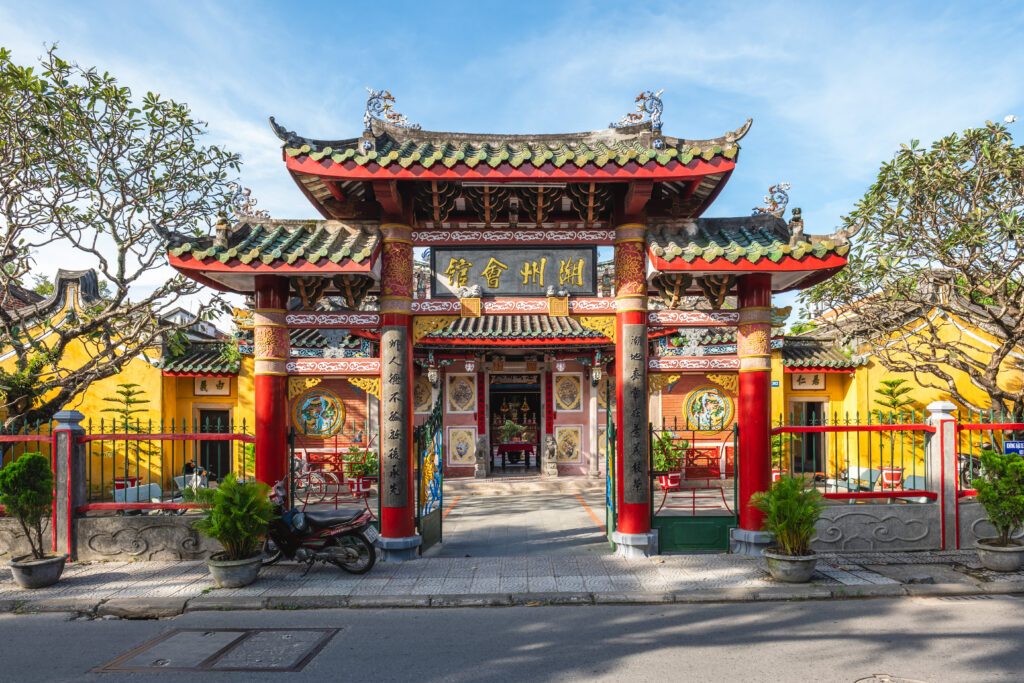
Location: 157 Nguyen Duy Hieu Street, Cam Chau Ward, Hoi An City, Quang Nam Province
One of Hoi An’s most captivating historical and spiritual landmarks, Trieu Chau Assembly Hall (also known as Am Bon Pagoda) stands as a testament to the craftsmanship and cultural heritage of the Chinese community in Vietnam. Built in the mid-19th century by Chinese traders from the Trieu Chau (Chaozhou) region of China, the assembly hall is dedicated to the worship of the sea deity, General Phuc Ba, who was believed to protect sailors and merchants on their voyages.
Why Visit Trieu Chau Assembly Hall
This nearly 170-year-old site offers a glimpse into the spiritual practices and architectural grandeur of the Chinese diaspora in Hoi An. The assembly hall was not just a religious sanctuary but also a place for social gatherings and community events for Chinese immigrants, particularly those involved in maritime trade.
The assembly hall impresses visitors with its elaborate wooden carvings, colorful ceramic figurines, and stunningly intricate roof design. The structure’s vibrant red pillars, intricately carved dragon motifs, and beautiful lacquer work create a striking visual experience. Walking through its ornate gate and into the spacious courtyard feels like stepping into a piece of history.
Highlights of Trieu Chau Assembly Hall
- Intricate Architecture: The architectural design of the assembly hall is a masterpiece, blending Chinese elements with local craftsmanship. The carvings on the beams and eaves are highly detailed, featuring dragons, phoenixes, and mythical creatures, symbolizing protection and prosperity.
- Spiritual Significance: The main altar of the assembly hall is dedicated to General Phuc Ba (Bon Dau Quan Am), who was revered for his ability to calm storms and protect sailors. The pagoda also features shrines to other deities and spiritual figures.
- Cultural Heritage: Beyond its religious role, the assembly hall was a community center for Chinese traders, offering a sense of belonging and protection for those far from their homeland. It continues to play a role in preserving the traditions of the Chinese-Vietnamese community in Hoi An.
What to Expect
- Ornate Design: From the beautifully decorated gate to the detailed wood carvings inside the hall, every inch of this assembly hall is a feast for the eyes.
- Offerings and Rituals: You might witness locals making offerings of incense, fruit, and flowers as they pray for blessings and protection.
- Historical Stories: The hall’s long history is intertwined with tales of the Chinese traders who played a vital role in Hoi An’s development as a major port city. Take the time to learn about the fascinating stories behind this spiritual site.
Practical Tips
- Visiting Hours: Trieu Chau Assembly Hall is open daily from 7:00 AM to 5:00 PM.
- Entrance Fee: Like many heritage sites in Hoi An, access to the assembly hall is included with your Old Town ticket.
- Respectful Dress: While there is no strict dress code, it’s advisable to dress modestly as you’ll be entering a place of worship. Avoid wearing overly revealing clothing.
Pro Tip
For the best experience, visit Trieu Chau Assembly Hall in the early morning when it’s quieter, allowing you to fully appreciate the intricate details of the architecture and the peaceful spiritual atmosphere.
Trieu Chau Assembly Hall offers a captivating blend of historical depth and spiritual significance, making it a must-see for anyone looking to explore Hoi An’s multicultural heritage. With its exquisite architecture and rich history, it provides a meaningful and visually stunning experience during your time in this ancient town.
Things to do in Hoi An: Embark on a Journey from Hoi An to Hue
Best things to do in Hoi An

The journey from Hoi An to Hue is not just a transfer between two historic cities; it’s an adventure that showcases some of Vietnam’s most breathtaking landscapes. The highlight of this route is undoubtedly the Hai Van Pass, a winding mountain road that offers panoramic views of the sea, mountains, and beaches, and was made famous by the popular Top Gear TV program. Whether you decide to travel by scooter, motorcycle, or car, this scenic route promises an unforgettable experience.
Conquer the Hai Van Pass
Stretching over 21 kilometers, the Hai Van Pass (meaning “Ocean Cloud Pass”) sits at an elevation of 500 meters above sea level. As you ascend the winding roads, you’ll be treated to sweeping views of the coastline on one side and lush, forested mountains on the other. On clear days, the pass offers some of the most stunning views in all of Vietnam. It’s no wonder it’s considered one of the most beautiful coastal roads in the world.
There are a few lookout points along the pass where you can stop, take pictures, and simply soak in the beauty of the landscape. The remnants of French and American bunkers at the top of the pass also offer a glimpse into Vietnam’s history, making it a must-visit spot for both nature lovers and history buffs.
Choose Your Way to Travel the Hai Van Pass
- Ride a Scooter: Adventurous travelers can rent a scooter and drive the pass themselves. It’s an exhilarating ride, but you’ll need to be confident on two wheels as the roads can be steep and winding. Be sure to wear a helmet and drive carefully, especially in bad weather.
- Hire an Easy Rider: If you’re not comfortable driving a scooter but still want to experience the thrill of a motorbike ride, you can hire an Easy Rider. These are experienced local drivers who will take you on the back of their motorcycle, allowing you to enjoy the scenery without worrying about the road.
- Relax in a Private Car with Driver: For a more relaxed journey, you can hire a private car with a driver. This is a great option if you want to travel in comfort while still enjoying the stunning views. Plus, a driver can stop at various scenic points along the way for you to take photos and explore.
Explore Sights Along the Route
- Climb the Marble Mountains: Located between Hoi An and Da Nang, the Marble Mountains are a cluster of five marble and limestone hills, each representing one of the five elements: metal, wood, water, fire, and earth. The mountains are home to a series of caves, temples, and pagodas, and offer stunning views of the surrounding countryside. A short stop here is highly recommended.
- Unwind at Lang Co Beach: Nestled at the base of the Hai Van Pass is the tranquil Lang Co Beach, a stretch of white sand and clear waters that is perfect for a quick break. It’s a great spot to relax, enjoy a fresh seafood meal, or take a dip in the sea before continuing on your journey.
- Relax at Elephant Springs: These natural springs are located near Lang Co Beach and provide a refreshing stop for travelers. The cool, clear water is ideal for swimming, and the surrounding rock formations and greenery make it a peaceful and scenic retreat.
Plan Your Journey with These Tips
- Time Your Journey: The direct drive from Hoi An to Hue takes around 3-4 hours by car or scooter, but plan for a full day if you want to stop at the various sights along the way.
- Check the Weather: The Hai Van Pass can be misty and slippery in the rain, so it’s best to check the weather forecast before setting out. Clear days offer the best views.
- Stay Safe: If you’re driving a scooter, be cautious on the steep, winding roads, and make sure to wear proper protective gear. It’s always safer to drive slowly and stay aware of other vehicles, especially large trucks and buses that may also be using the pass.
Pro Tip
For an even more scenic and relaxing experience, consider combining your road trip with a train journey. The coastal train between Da Nang and Hue passes through the Hai Van Pass as well, offering stunning views of the coastline and mountains without the stress of navigating the road.
Whether you choose to drive the Hai Van Pass yourself or let someone else do the driving, the journey from Hoi An to Hue is sure to be a highlight of your time in Vietnam. With stunning vistas, fascinating historical sites, and plenty of opportunities to stop and explore, it’s more than just a route—it’s an adventure in itself.
FAQs About Visiting Hoi An
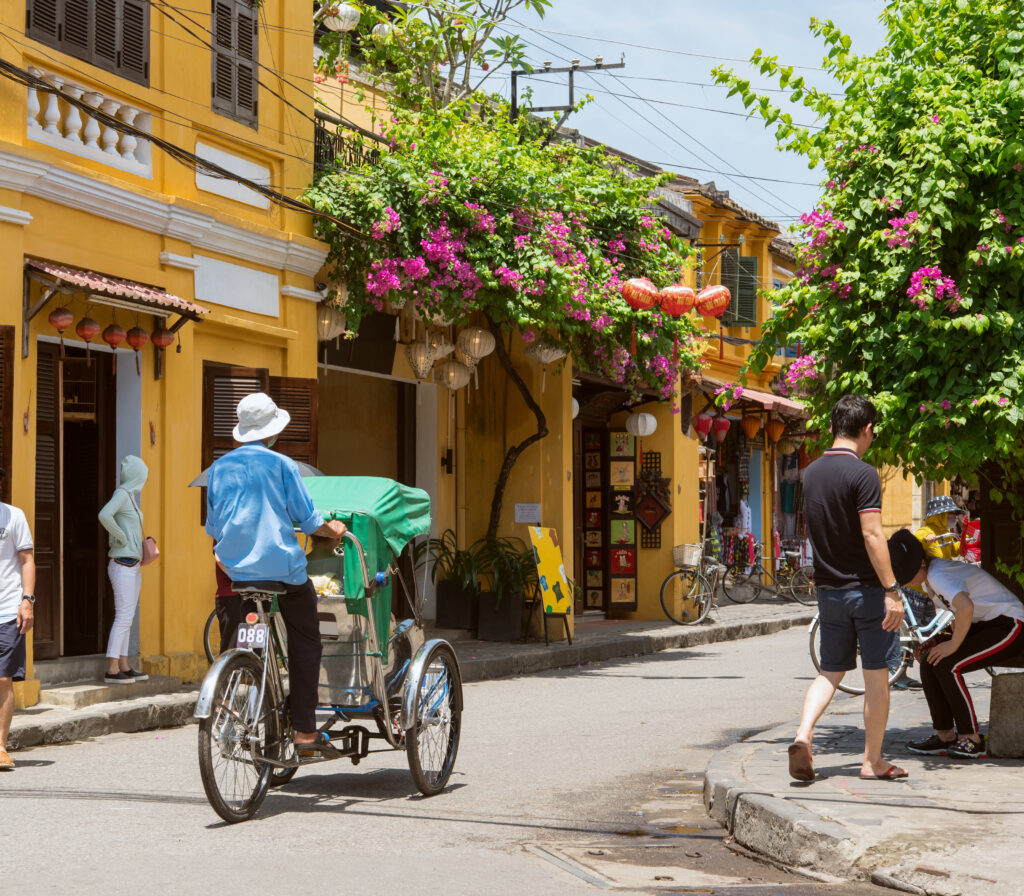
When is the best time to visit Hoi An?
The best time to visit Hoi An is between February and April, when the weather is mild, and rainfall is low. However, the town is beautiful year-round, with each season offering its own charm. If you’re interested in learning more about the best time to visit not just Hoi An but all of Vietnam, check out our detailed guide on the Best Time to Visit Vietnam for a deeper dive into seasonal insights and tips across the country.
How many days should I spend in Hoi An?
A minimum of 3-4 days is recommended to explore Hoi An and its surroundings comfortably. This allows time to discover the Ancient Town, enjoy cultural activities such as tailor-made shopping or a cooking class, relax at the beach, and take a few day trips to places like My Son Sanctuary or Cham Island.
Is Hoi An safe for solo travelers?
Yes, Hoi An is considered very safe for solo travelers. The town’s laid-back atmosphere, friendly locals, and low crime rate make it a great destination for solo adventurers. However, it’s still important to take common sense precautions, especially when exploring the area at night or when walking in less crowded areas.
Can I drink tap water in Hoi An?
It’s not recommended to drink tap water in Hoi An. Stick to bottled water, which is readily available in shops, restaurants, and hotels. Use bottled or boiled water even when brushing your teeth, as the tap water is not treated for consumption.
What’s the dress code for visiting temples in Hoi An?
When visiting temples, it’s essential to dress modestly out of respect for local customs. Cover your shoulders and knees, and remove your shoes before entering sacred spaces. A lightweight scarf or shawl can be useful for covering up when needed, especially during the hot months.
Are credit cards widely accepted in Hoi An?
While larger hotels and restaurants accept credit cards, many smaller establishments, local shops, and markets operate on a cash basis. It’s advisable to carry some Vietnamese Dong with you, particularly when visiting street vendors, small eateries, or craft markets.
Is it necessary to book cooking classes and boat tours in advance?
During the peak tourist seasons (July-August and December-January), it’s recommended to book popular activities in advance. This is especially true for sought-after activities such as cooking classes, lantern-making workshops, and boat tours along the Thu Bon River. By booking early, you can secure your spot and ensure availability for your preferred dates.
Visiting Hoi An offers a mix of rich cultural experiences, relaxation, and adventure, making it one of Vietnam’s top destinations for all types of travelers. With these tips in mind, you’re well-prepared for a memorable trip to this enchanting town!
Let’s Wrap It Up
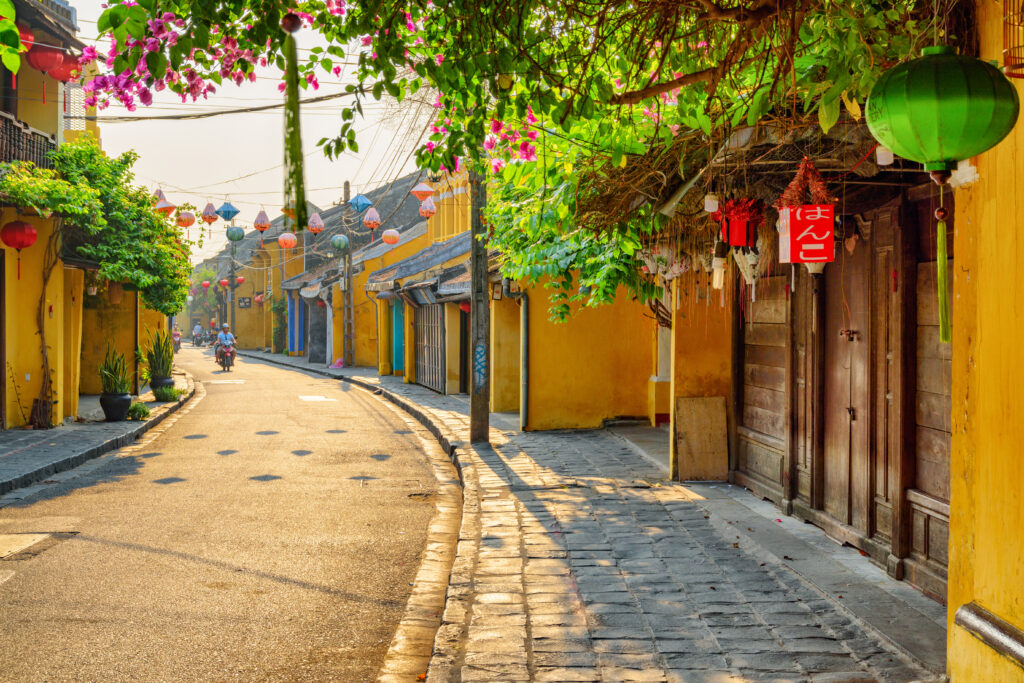
Hoi An is more than just a picturesque town; it’s a place where history, culture, and natural beauty converge, offering an unforgettable experience for every traveler. Whether you’re exploring its ancient streets, cycling through the peaceful countryside, or indulging in its rich culinary traditions, Hoi An invites you to slow down and embrace its timeless charm.
If you’re interested in discovering more of Vietnam, check out 25 Unusual Things to Do in Ho Chi Minh City for unique adventures. If nightlife excites you, consider 20 Things to Do in Ho Chi Minh City at Night, or plan your perfect family vacation with 25 Things to Do With Kids in Ho Chi Minh City. Whether it’s romance, food, or history, there’s always more to explore in this fascinating country, like Top 10 Romantic Things to Do in Ho Chi Minh City or 26 Things to Do in Chinatown.
Hoi An’s lantern-lit nights, vibrant markets, and welcoming locals create an atmosphere that feels both enchanting and familiar. Nearby beaches and islands offer a refreshing escape from the hustle of daily life. As you stroll through its lantern-lit alleys or savor local delicacies, you’ll understand why so many fall in love with this unique destination.
Take your time in Hoi An—each moment is a chance to connect with Vietnam’s rich heritage. Whether you’re here for a few days or longer, the experiences you gain will be unforgettable.




